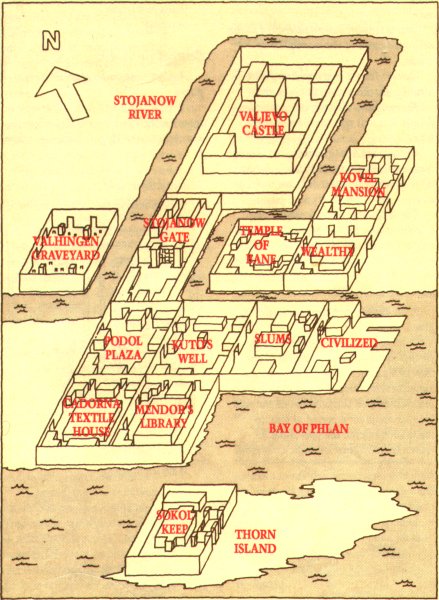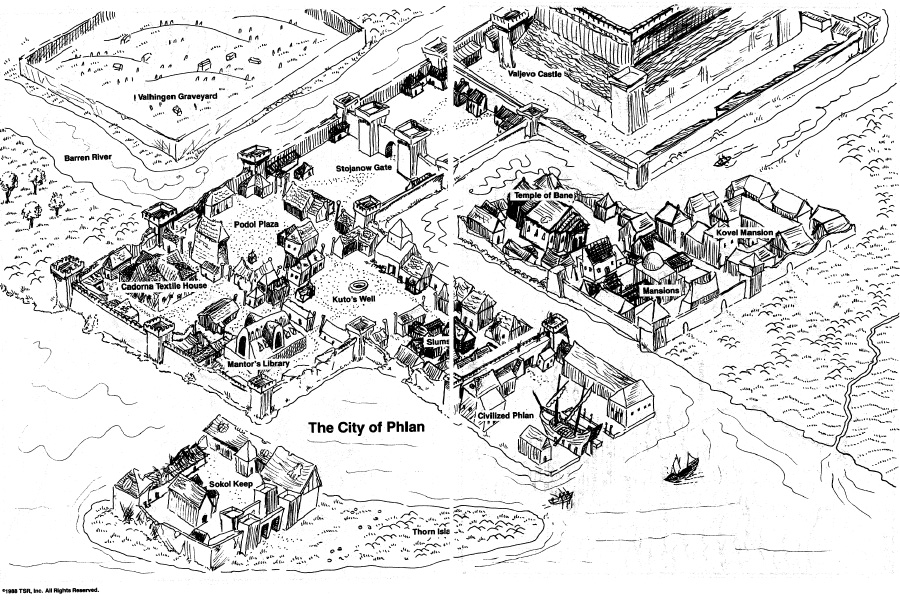Foundations of Adventure
:strip_icc()/pic564253.jpg) In 1988 SSI released the first of their celebrated “Gold Box” games, Pool of Radiance. TSR cashed in on their new AD&D and Forgotten Realms tie-in with a novel… loosely… based on the game, and 96-page adventure module, Ruins of Adventure. While Pool of Radiance was pretty solidly focused on being a solid computer RPG using the AD&D rules and Forgotten Realms setting, Ruins of Adventure isn’t so focused.
In 1988 SSI released the first of their celebrated “Gold Box” games, Pool of Radiance. TSR cashed in on their new AD&D and Forgotten Realms tie-in with a novel… loosely… based on the game, and 96-page adventure module, Ruins of Adventure. While Pool of Radiance was pretty solidly focused on being a solid computer RPG using the AD&D rules and Forgotten Realms setting, Ruins of Adventure isn’t so focused.
Generally, it is a regular large adventure module, perfect bound, with no detached maps or anything. It also attempts to be a hint book for Pool of Radiance, which means it sticks to the format of that game more than is wise for a good adventure. The computer game required breaking up into 16×16 grid areas for the party to move around in, and many of the maps are taken directly from that, which helps on the ‘hint book’ end, but causes a lot of the maps to look very primitive, being a square grid with thin wall-lines.
The high concept is good for a moderate-sized campaign: Years ago, the city of Phan was overrun by various monsters, who seemed better organized than usual. Now, descendants of the leading citizens of the city are trying to reclaim it, and are hiring adventurers to clear it out for resettlement. In the computer game, the city is divided up into a bunch of ‘blocks’, and the party is given missions to clear portions of the city.
The module follows much the same format, with each block being a small chapter giving all the relevant details. Mostly. In some places there is a distinct lack of detail, with two sections being one-page ‘chapters’ consisting of the 16×16 map and a couple paragraphs, which include reference to the random encounter tables in the back. In fact, the random encounters is one of the more worked out areas, with 15 different tables, that reference each other.
The initial setup for the campaign is fairly nicely done, with an overview of the main plot, a bunch of NPCs for the party to hire, and a set of business for the party to interact with (including such things as a nice inn that’s the target of thieves, and a rough dive that all the thieves stay in, so possessions are relatively safe). After that, it starts coming apart. The theory is that the city council is posting rewards for getting certain things done, and one particular councilmember should take an early interest in the party, and use his patronage of their successes to improve his position. But while the introductory sections establish all this, it never gets any real attention.
An interesting bit is that SSI and TSR provided similar overview maps of the city, but the one in Ruins of Adventure is much nicer looking.
 |
 |
When not dealing with the really bare-bones sections, there are some planned encounters. One area has the party deal with a bunch of orcs and goblins that have some fairly effective tactics outlined for them. Actually, that’s something of a repeating theme, there’s several places where the monsters have set up shop intelligently, and the players could easily have a rough time of it. Most of the areas feel very random in layout, and the descriptions don’t help, but there are a couple areas that got more attention. The absolute worst section is Valhingen Graveyard, where the map doesn’t even match the descriptions (large structures that don’t appear on the map).
The big bad and final confrontations are about halfway through the module. After that, there’s several short chapters dealing with things in the wilderness outside of Phlan. One of these is tied directly into the overall plot, and one other is tied directly to the main goal of restoring Phlan. The rest… are things the party may or may not stumble across, depending on if they get an itch to explore. They do help populate the region, and if this is run as more than just a ‘clear the city’ adventure, will help out. However, they do tend to be very combat heavy (fighting hundreds of monsters is a recurring theme here), with no negotiating options, though there is one that can be peaceful if the characters were smart in an earlier bit.
As a whole, there’s some really good ideas in this module… but they don’t get past the idea stage. In fact, the module feels like it needed a lot more room to be fleshed out in, and would have made a decent 128+ page supermodule, but is instead a poor 96-page one. Most of the sections have pretty concrete ideas of what’s there, and what the characters will be facing, but nowhere does the module say how many characters and what levels are expected (it is in fact unhelpfully hand-waved away in the text). The overall plot gets a good description, but there’s only occasional concrete hooks to it in the main part of the module. But, for a DM who wants to do a the additional work, the skeleton of a good campaign is here.

Discussion ¬